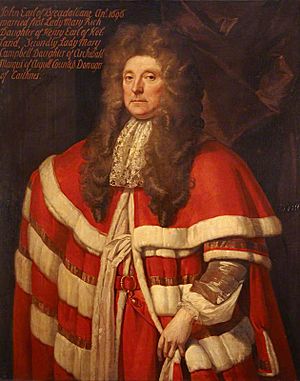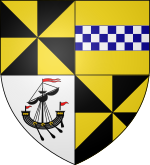John Campbell, 1st Earl of Breadalbane and Holland facts for kids
John Campbell, 1st Earl of Breadalbane and Holland (born 1636 – died 1717) was an important Scottish nobleman. He lived during a time of big changes in Scotland, including the Glorious Revolution and the Jacobite uprisings. People sometimes called him "Slippery John" because he was very clever and often changed sides to get what he wanted. He was also involved in the sad event known as the Massacre of Glencoe.
Contents
Life Story of John Campbell
John Campbell was the oldest son of Sir John Campbell of Glenorchy. His mother was Lady Mary Graham. In 1654, he joined a royalist uprising, but it didn't succeed. Later, he encouraged George Monck to help bring the king back to England. This event is known as the Restoration.
From 1669 to 1674, John Campbell was a member of the Scottish parliament. He represented the area of Argyllshire.
Becoming an Earl
In 1672, John Campbell gained control of the lands of George Sinclair, 6th Earl of Caithness. This happened because he was Sinclair's main creditor. When the 6th Earl died without children, John Campbell became the Earl of Caithness.
In 1678, he married Mary Campbell, who was the widow of the former Earl of Caithness. This marriage saved him a lot of money. In 1680, he led 800 men into Caithness. They fought and defeated the Sinclair family at the Battle of Altimarlach.
However, the true heir to Caithness was later confirmed by the Scottish Parliament. So, in 1681, John Campbell received a new title. He became the Earl of Breadalbane and Holland. He also gained other titles like Viscount of Tay and Paintland. In 1685, he joined the Scottish privy council, a group of royal advisors.
Working with the Government
John Campbell was known for having a very good wig in Scotland. He was also very influential. Only his cousin, the Duke of Argyll, had more power than him. This made John Campbell always try to gain more power.
It was important for King William III to get John Campbell's help. The king wanted to make peace with the Highlanders. At first, Breadalbane talked with Dundee and was involved in a plot against the government. But after the battle of Killiecrankie in 1689, he offered to help the government.
He swore loyalty to the king. The government then gave him a lot of money. This money was meant to get the Highland clans to submit to the king. In 1691, he met with the Jacobite chiefs. He convinced them to stop fighting for a few months. He used threats and promises to get them to agree. Many believed he kept most of the money for himself. When asked about the money, he famously said: "The money is spent, the Highlands are quiet, and this is the only way of accounting between friends."
Glencoe and Later Years
John Campbell had a reputation for being tricky. This led many to believe he was directly involved in the Massacre of the Macdonalds of Glen Coe in 1692. However, he was one of the few who understood the damage this event caused.
Later, it was discovered he had been talking with the Jacobite chiefs. He was put in Edinburgh Castle in September. But he was released when it was known that King William knew about his actions.
Breadalbane did not vote for the Union of Scotland and England in 1707. However, he was chosen to be a Scottish representative in the British Parliament from 1713 to 1715. His help in calming the Highlands was not out of loyalty. He even encouraged a French plan against England in 1708.
In 1715, during the Jacobite rising, he claimed he was too old and sick to join. But the next day, he visited Jacobite camps. People believed he was trying to trick others and get French money. He took money to provide 1200 men for the uprising but only sent 300. These 300 men left after the Battle of Sheriffmuir. John Campbell died on March 19, 1717. His death meant there was no need to investigate his actions further.
Family Life
John Campbell married Lady Mary Rich in 1657. They had two sons. Their son Duncan was passed over for the title in 1685. Their second son, John Campbell, 2nd Earl of Breadalbane and Holland, inherited the title.
In 1678, he married Mary Campbell, the widow of the 6th Earl of Caithness. With his second wife, he had a third son named Colin. He also had an illegitimate daughter, Mary Campbell. She later married Sir Archibald Cockburn. Lord Breadalbane passed away on March 19, 1717.



